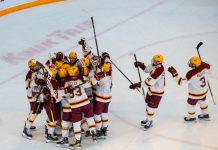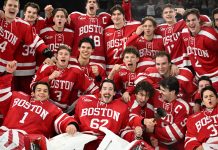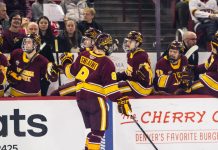University of Alaska-Fairbanks hockey coach Dave Laurion sighs. “The first five games of the year, soon after Erik got hurt, we weren’t very good. All of our returning players who knew Erik didn’t play well. Right away, we’re oh-and-seven at home against good teams, when we’re not playing our best hockey.”
He pauses. In his voice are sadness and frustration — for his team, the Nanooks, and for one player in particular. “That first Lake State game has got us behind the eight-ball now. We should have won that one.”
Another pause. “I’m surprised we haven’t won a game at home, but we’ve been beat by some good hockey teams.”
There’s more to the Nanooks’ shaky start than a tough early CCHA schedule. Sophomore defenseman and Fairbanks native Erik Drygas lost his skate edge and went head-first into the boards during a preseason, non-contact drill on Oct. 7. Drygas severely fractured his fifth cervical vertebra and remains partially paralyzed, with only limited movement in his extremities. His prognosis is uncertain. For a team whose roster boasts seven Fairbanks natives and 11 native Alaskans overall, and in a city of just 31,655, Drygas’ injury is even more personal, closer to home, than it might otherwise be.
“The UAF hockey program is more a community program, in some ways right now, than a school program,” says Eric Carlson, keeper of the Nanooks’ Web site and board member of the UAF Hockey Face Off Club. “I have a feeling that makes it somewhat different than some of the other CCHA programs.”
Officially in its second year of CCHA play, the UAF hockey program is, indeed, different from other programs in its league. For one thing, this member of the Central Collegiate Hockey Association is just a two-hour drive from Mt. McKinley, and a mere 200 miles south of the Arctic Circle.
At this time of year, the sun rises at about 10:45 a.m. and sets at roughly 2:45 p.m. The school is literally a thousand miles from its nearest CCHA opponent. According to the Fairbanks Convention and Visitor’s Bureau, Fairbanks is “an easy gateway into the Alaskan wilderness.” The Bureau also claims that Fairbanks is the “dog mush capital of the world.”
This isn’t South Bend. It isn’t even Sault Ste. Marie.
This remote location shapes the way in which the Nanooks recruit, and therefore the personality of the team. The Nanooks are the second-oldest team in Division I men’s ice hockey, with an average age of 21.67. Two Nanooks, goaltender Ian Perkins and forward Sean Fraser, are married; Fraser is a father.
In a recent article in the Fairbanks Daily News-Miner, assistant coach Tavis MacMillan theorized that the Fairbanks location attracts more mature players, players who can handle living in the frontier of the Alaskan Interior. Said MacMillan, “It’s a tough transition to move from western Canada or wherever to anywhere…but from the prairies to Alaska, it’s tough for any kid to handle.”
Another factor that separates UAF from its more established and centrally located counterparts in the CCHA is its lack of history as a hockey powerhouse. While Michigan and Lake Superior State compete for and attract the hottest 18-year-old recruits, UAF tends to recruit older players who are at the peak of their play, players who don’t sign with the glossier programs.
These players bring a maturity to the program that manifests itself on and off the ice. According to Carlson, on a recent flight back to Fairbanks after a “road” trip, the flight crew made a point of telling Dave Laurion what a pleasure it was to have the Nanooks on the flight, and that they were the best team with which the crew had ever traveled.
Mature players, native Alaskans and hometown boys, a remote location…it all adds up to a unique hockey program. “We’re a small community a long ways away,” says Laurion. “We’re a tight group. We work hard to get the best Alaskans who want to play for us.”
In addition to the other challenges of recruiting players from “The Outside” to come to Fairbanks, UAF competes with sister school Alaska-Anchorage for in-state talent. “Our drawing area is very small,” says Laurion. “The population of the areas surrounding and between Fairbanks and Anchorage is roughly 300,000 people, which is a lot smaller than, say, the Toledo, Ohio, area.”
The number of hometown players has a positive effect on the community. When Eric Carlson was growing up in the sixties and early seventies in Fairbanks, he says he never dreamed of playing any sport at the Division I level.
“Now,” says Carlson, “kids from Fairbanks see local players like Erik Drygas, Fred Scott, Greg Milles, Kirk Patton, and now Brian Upesleja and Kerry Hafele. They see that things can happen for them, too, whether it’s in sports or any other field.
“To look at the number of kids involved in local youth hockey now is amazing. When I grew up there were maybe a couple dozen die-hard hockey players hitting the ice outdoors in very cold temperatures.” Now, according to Carlson, the local youth hockey programs are flourishing, thanks in part to Barb and Chuck Milles, the parents of former Nanook Greg Milles.
The UAF fan base is made up primarily of Fairbanks residents. “We are constantly talking about how to get students more involved,” says Carlson, “but we don’t have the long tradition of a school like Michigan State. The injury to Erik kind of dampened a lot of [fan] enthusiasm, because he is always in the back of our minds.” Carlson says that the team’s current struggles on the ice are affecting fan reaction as well. “But we are still trying to stay behind them, nonetheless. You know, you just hope they realize it.”
Immediately after Drygas’ injury, before he was moved for treatment to Craig Hospital in Colorado, his proximity was difficult for his teammates. Visiting Drygas daily exacted an emotional toll on the players, which of course had an impact on the Nanooks’ game. “Every day that goes by we still keep in touch with Erik,” says Laurion, his voice low. “But now the constant reminder isn’t there.”
At the Nanook season opener on Friday, Oct. 11, Drygas was introduced as an honorary member of the starting lineup. His jersey will be placed on the bench for every game, until he is able to come back and wear it himself.
The feeling among Nanook fans and the coaching staff is that it’s time for the healing to begin, for everyone on the team. “It’s been a frustrating year for us,” says Laurion. “We need to play well, to win some games, to get some confidence back.”


